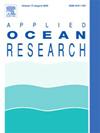Temperature-dependency and boundary condition impacts on the multiscale vibrational behavior of laminated nested dual conical shell structure semi-AUV applications
IF 4.3
2区 工程技术
Q1 ENGINEERING, OCEAN
引用次数: 0
Abstract
This investigation examines the vibrational behavior of a novel shell structure, nested dual conical shells (NDCSs), and a truncated conical shell (TCS) under varying thermal conditions. The conical shells are composed of two parts, matrix and reinforcement. Polymethyl methacrylate (PMMA) employed as the matrix and single-walled carbon nanotubes (SWCNTs) considered as reinforcement, with mechanical properties that are influenced by ambient temperature. Considering the rule of mixtures (RoM), the tantamount mechanical characteristics of these smart composite materials (SCM) are determined, leading to the development of a comprehensive mathematical model. The First-Order Shear Deformation Theory (FSDT) and Donnell's approach are applied to establish the relationship between forces and strains. Subsequently, Hamilton's principal is used to derive governing deferential equations (GDEs) of NDCSs and TCS. The GDEs are solved through a numerical approach, called Generalized Differential Quadrature Method (GDQM). This research incorporates the boundary conditions (BCs) through the implementation of arbitrary constraints, allowing for an in-depth examination of the relationship between boundary stiffness and the natural frequency parameters (NFP) of NDCSs. The findings reveal that the NFP depend considerably on the distribution and volume of nanofillers, as well as the orientation of nanofillers under different thermal conditions. Numerical analyses show that as the temperature increases, the NFP decreases. Additionally, the results highlight that the highest NFP occur at specific reinforcer orientations, such as 60°, 120°, 240°, and 300° for the first mode, while 90° and 270° yield peak values for higher modes. The analysis reveals unique vibrational phenomena specific to the NDCSs structure, including the significant role of middle tier springs' stiffness, which governs the NFP behavior within a specific stiffness range.
求助全文
约1分钟内获得全文
求助全文
来源期刊

Applied Ocean Research
地学-工程:大洋
CiteScore
8.70
自引率
7.00%
发文量
316
审稿时长
59 days
期刊介绍:
The aim of Applied Ocean Research is to encourage the submission of papers that advance the state of knowledge in a range of topics relevant to ocean engineering.
 求助内容:
求助内容: 应助结果提醒方式:
应助结果提醒方式:


